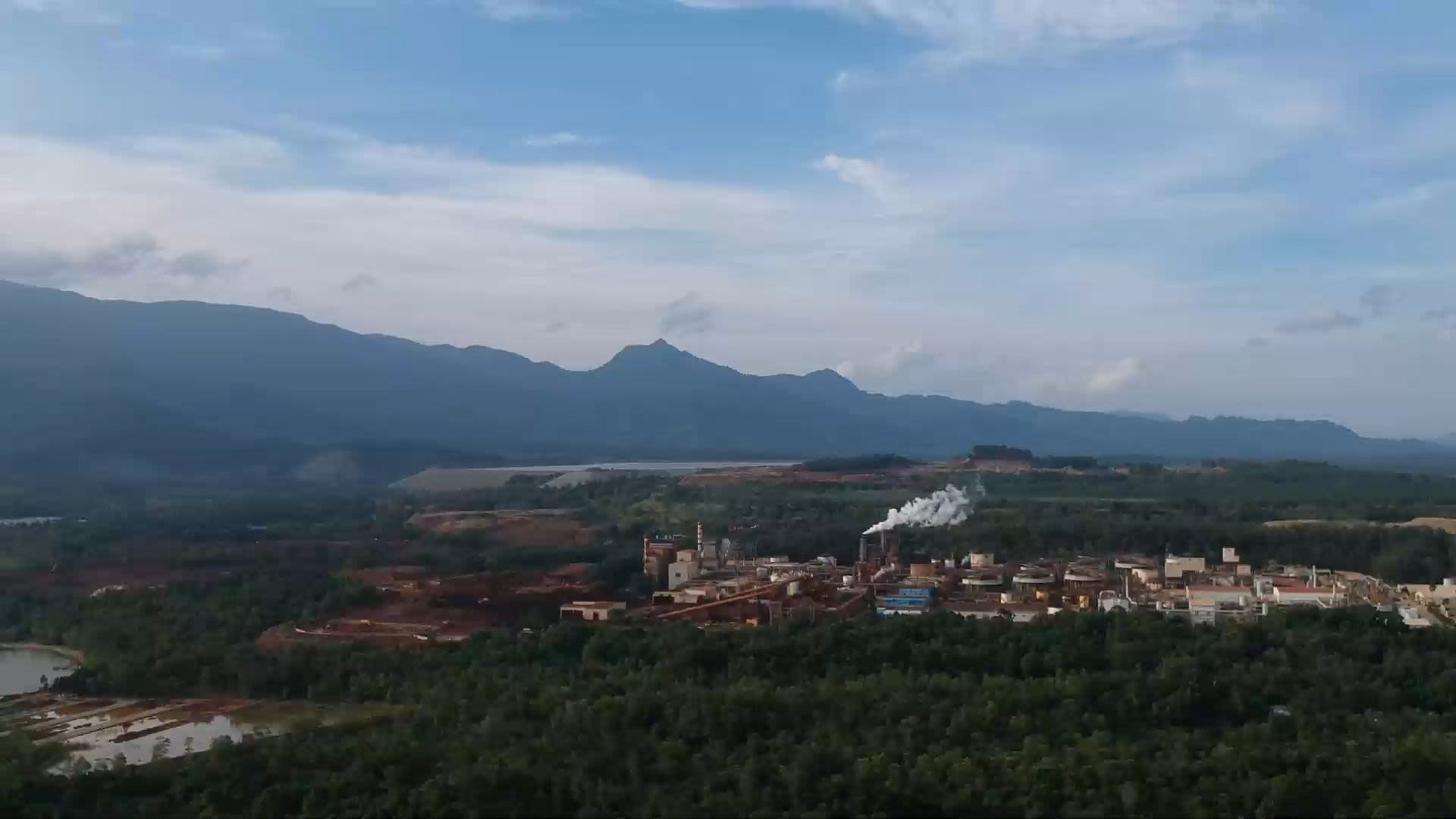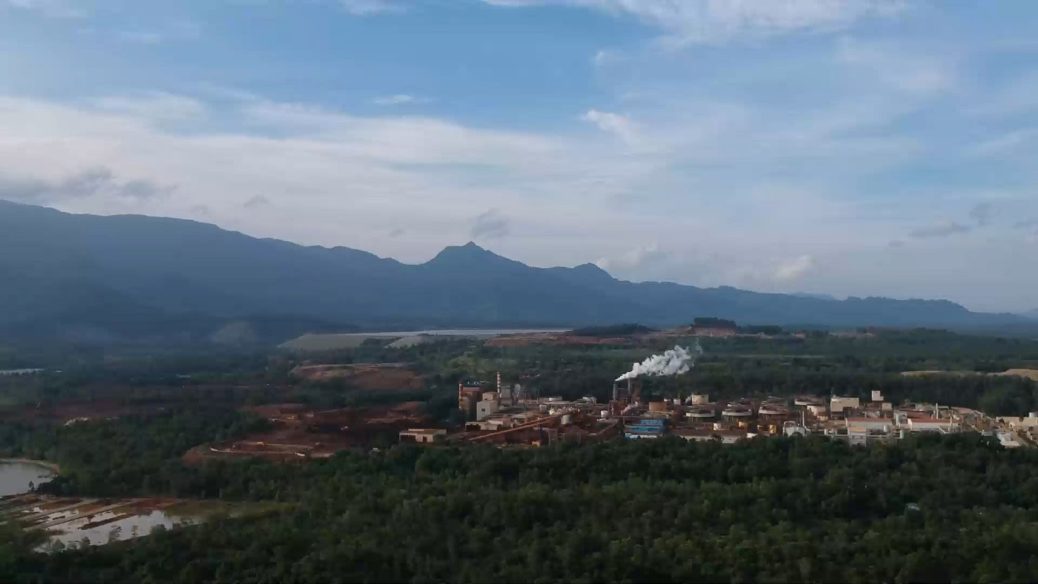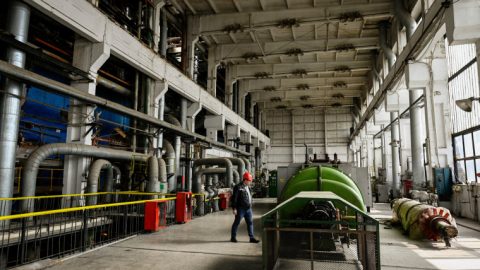
Sumitomo Metal Mining holds a roughly 25 percent stake in the company that owns the Rio Tuba mine – Nickel Asia, which is based in the Philippines.
The mine has an outsize presence in Bataraza. One of its main high schools, supermarkets and municipal buildings all carry the name Rio Tuba, a testament company officials say to the development the mine brought to the area.
“The town of Bataraza before mining started was a fourth-class municipality, which in the Philippine classifications is the poorest of the poor,” Jose Baylon, a spokesman for Nickel Asia, said.
Macadam Highway is Rio Tuba’s link to the global supply chain. (Kimberly dela Cruz for NBC News)
Macadam Highway is Rio Tuba’s link to the global supply chain. (Kimberly dela Cruz for NBC News)
The town is now considered a first-class municipality, he said, a designation that puts it just below a city. Among the town’s major upgrades: a water system that Nickel Asia paid for at the request of government officials.
“It is made possible because of the income generated by the mining,” Baylon said.
The mine began operations in the mid-1970s after the Rio Tuba Nickel Mining Corp. secured the permission of the Philippines government. At the time, the nickel ore pulled out of the earth was mainly used in the production of stainless steel.
The operation took on new prominence after the turn of the century with the rise of electric cars. Nickel is a key component in the lithium batteries that power the vehicles, and there’s only one way to get it: digging up the earth.
“Nickel is our biggest concern for scaling lithium-ion cell production,” Tesla Chief Executive Elon Musk tweeted earlier this year.
NBC Nightly News examines how growing demand for electric vehicles puts rainforests at risk.
NBC Nightly News examines how growing demand for electric vehicles puts rainforests at risk.
Advances in clean energy coincided with new technology that allowed companies like Nickel Asia to extract nickel from a different type of ore. A process called high pressure acid leaching made it possible to extract nickel from low-grade laterite ore.
But the technique comes at a price: because the materials lie at the surface, as opposed to deep underground, miners must clear out a wider swath of land.
“You are fundamentally having to move more ore out of the ground, and obviously that has a bigger footprint from a mining perspective,” said Andrew Miller, chief operating officer at Benchmark Mineral Intelligence, which tracks the supply chain for electric vehicles.
Over time, the Rio Tuba mine swallowed up more of the rainforest.
The Rio Tuba mine doubled in size between 1987 and 2020. Satellite imagery shows its growth. (USGS / NASA Landsat / Earthrise)
The Rio Tuba mine doubled in size between 1987 and 2020. Satellite imagery shows its growth. (USGS / NASA Landsat / Earthrise)
Alarmed by the potential consequences, environmental and Indigenous rights groups marshaled their resources.
In 2010, the Indigenous peoples advocacy group Ancestral Land/Domain Watch and the Centre for Biocultural Diversity of the University of Kent in the United Kingdom released a sharply-worded report calling for an end to mining operations in the area.
“The continuation of mining activities in Bulanjao will irremediably damage the best conserved forest in the southern tip of Palawan, with predictable adverse consequences for the food production capacity of both indigenous and migrant farmers communities living at the foot of this mountain range,” the report said.
“Because of mining activities taking place at high elevations, the risk of landslides is likely to increase to an unprecedented level. Also, the eco-tourism potential of this mountain forest is likely to be jeopardized.”
Two years later, the nonprofit environmental group, Friends of the Earth Japan, announced that it completed an environmental field study in Palawan that it said found unsafe levels of hexavalent chromium, a cancer-causing chemical that was at the center of the Julia Roberts film “Erin Brockovich,” in one of the rivers near the mine.
In an interview, Hozue Hatae, a researcher at Friends of the Earth Japan, said the group launched the tests after conducting a 2009 survey with 133 households that found 85 percent reported experiencing an uptick in coughs and other respiratory issues, as well as skin lesions.
The group conducted annual tests on the Togpon River from 2009 to 2019, which found that in the rainy season, it exceeded the hexavalent chromium exposure levels used by the World Health Organization in determining the safety of drinking water.
Last month, the reporting partner for this story, the Philippine Center for Investigative Journalism, conducted water tests along the Togpon River and the Kinurong Creek. Four of the seven samples taken at different points along the waterways showed levels of hexavalent chromium higher than the WHO standard for drinking water.
Multiple people who live near the area said in interviews last month that locals stopped using the river and the creek for drinking water years ago after the water developed a reddish hue.
Nickel mines have been found to increase the release of soluble chromate into groundwater and surface water, experts say. The risk grows when proper containment measures are not in place. But it’s difficult to establish a definitive link between a mine and high chromate levels without water test results that predated the operations.
A reporter takes a water sample at the estuary of the Tuba River where the Togpon River merges. (Kimberly dela Cruz for NBC News)
A reporter takes a water sample at the estuary of the Tuba River where the Togpon River merges. (Kimberly dela Cruz for NBC News)
Two experts – Jennifer De France, team leader of drinking water quality at the WHO, and Murray McBride, a professor of soil science at Cornell University – said it was possible that the level of chromate in the water was a natural occurrence that resulted from high concentrations in underlying rocks.
Whatever the cause, McBride said, it could be detrimental to the rice paddies in the area.
“There is potential for crop damage from chromate accumulated in soil, as well as possible risk to human health if chromate levels in soils are too high,” he said.
Baylon, the Nickel Asia spokesman, pushed back at the idea that the mine was contaminating the water. He said Rio Tuba’s initial sampling in December 1996 showed “escalated values of hexavalent chromium in nickel mining water before the peak of the mining operation.”
He said Rio Tuba conducted a 2018-2019 study with the National Institute of Geological Sciences at the University of the Philippines, Diliman, that showed hexavalent chromium in surface waters exiting the mine were at low levels while the metal in groundwater was generally undetected.
“The mine drainage system is designed to direct the mine surface runoff straight to the Rio Tuba River and not for drinking, irrigation or agricultural purposes,” Baylon said. “Therefore, it is very unlikely that mine waters, or Cr6+ (hexavalent chromium) will enter the local water supplies.”
He acknowledged that mining operations invariably impact the environment, but he noted that throughout history technological advances have come at a cost.
“I think human development has been a series of trade-offs over the years,” he added. “Part of what we’re suffering through today is paying off the coal factories, which made the industrial revolution possible.”
Baylon emphasized that his company takes a series of steps to mitigate the mine’s impact on the land, including a sophisticated process of planting trees over the mined area. He noted that Rio Tuba has received multiple honors, including the best practice in minerals mining award in the first Association of Southeast Asian Nations’ Mineral Awards in 2017.
“We cannot castigate a whole industry because there are some irresponsible operators,” he says. “Life has been a series of trade-offs, and we’re still trading off. But I think the trading off now is getting much better than it was.”
Representatives from Tesla and Toyota did not respond to requests for comment. A Panasonic spokesperson declined to comment.










Recent Comments